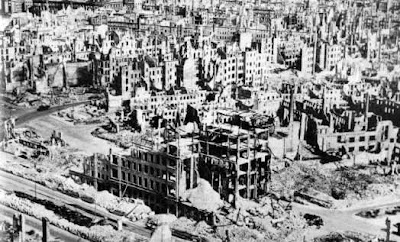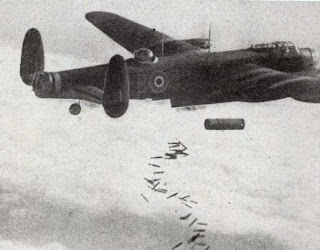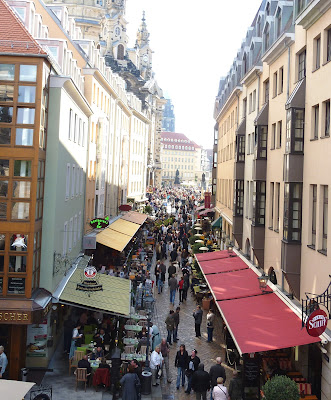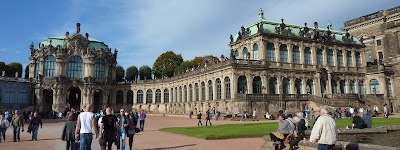Dresden is a “New” Mini-Prague
 |
| Dresden today has been rebuilt into a gorgeous, Baroque city. |
They say that no one is building a city like Prague anymore, but that’s not quite true. Most of the gorgeous Baroque, “Old Europe” city you see in the heart of Dresden, Germanytoday is brand new, even though it appears to look centuries old.
From Medieval-looking back alleys to grand cathedrals, from an impressive Baroque opera house to beautiful bridges, from huge squares lined with colorful cafes to a river teeming with nine steamboats, central Dresden ranks for sheer beauty with any of the great cities of Europe. While the historic center is smaller than Prague, street for street, Dresden has the same feeling. Located midway between Berlin and Prague (just two hours from each city by train) it makes a romantic stopover city, but one that many North Americans have yet to discover.
 |
| Dresden after the bombing |
Of course, the reason everything in Dresden is new is because the city was completely destroyed in World War II in one of the most horrific bombing raids the world has ever known. At the outbreak of the War, Dresden was a university town, renowned for its architecture, art treasures, history and beauty. Because of its celebrated status as one of the most elegant cities of Europe and because there were no military targets here, Dresden escaped bombing for almost the entire war. Through the London Blitz, the D-Day landings at Normandy and the Battle for Berlin, life in Dresden was fairly normal. But all that changed on the night of Feb. 13, 1945.
 |
| British Lancaster bomber |
Allied Air Marshal Arthur “Bomber” Harris had devised a plan to destroy the will of the German people to fight by leveling their cities. Dresden, with its medieval wood buildings on narrow streets, gave Harris the target he was looking for to experiment with firestorms.
Just two months before the end of the war, some 244 British Lancaster bombers dropped 800 tons of bombs on central Dresden, including 10-ton mega bombs called “blockbusters.” Each of these bombs literally blew the roof off an entire block of buildings. With the roofs gone, the city had no protection when the second wave of 529 Lancasters filled the skies some hours later, dropping 1,800 hundred tons of phosphorescent “sticky” fire bombs that fell on the exposed buildings and began fires wherever they stuck.
 |
| Dresden today. |
A third wave of 311 U.S. “Flying Fortresses” came the next morning, when fire crews and survivors were on the street. This third wave of bombs created a draught that united individual fires into one huge firestorm that swept across 75% of Dresden, using up so much oxygen that city dwellers were suffocated, even in their underground bomb shelters. The horror of that night was captured by American author Kurt Vonnegut, who was a prisoner of war in Dresden and wrote about it in his classic novel, Slaughterhouse Five.
When the bombing finally stopped, 25,000 civilians were dead and Dresden was an inferno – so completely, utterly destroyed that many questioned if it should, or even could, ever be rebuilt. Ironically, the railroad through the city, the alleged target justifying the bombing raid, was hardly damaged.
| The Oper House in Dresden. |
In the Cold War, Dresden was part of East Germany and there was little money for restoration so the city center remained in piles of rubble… or worse, much of the city was bulldozed and rebuilt with cheap, ugly cinderblock.
| The Frauenkirche church was rebuilt in 2005 |
But with the collapse of the Berlin Wall and the reunification of Germany in 1990, millions of Euros poured in to the city and Dresden’s entire center was restored to its old beauty. The results are simply incredible. Dresden’s city center is once again an Old World marvel of towers and turrets, squares and arches, murals, churches, statues and theatres. As you sit in a café sipping a beer, surrounded by a beautiful Baroque city teeming with young people and tourists, it’s impossible to believe this is the same bombed out ruin pictured in the postcards in every shop. But look closely at all the “old” buildings. The white stone used in them is new, but the black squares used here and there are bits of old stone salvaged from the ruins and put back in place, as if building a giant jigsaw puzzle.
| The Parade of Nobles |
Other old things remain. The Parade of Nobles, an amazing block-long mural of 24,000 tiles, is all original. The ceramic tiles, depicting 700 years of Saxon history and clothing, were already fired twice when they were created, so the temperatures of the firebombing didn’t hurt them: in fact, the firebombing temperatures were actually cooler than their original firing.
The city’s visitor center has walking tour brochures in all languages, and it’s possible to take guided tours by foot, by horse-drawn carriage or by boat along the Elbe River. You could see the center in a day, but it’s even more magical at night when the buildings are illuminated. Dresden also makes an excellent base for a series of day-trip adventures in the surrounding countryside.
 |
| Munzgasse is lined with outdoor cafes |
With 40 museums, there’s shortage of things to see; some of the “must do” Dresden experiences include:
· Have a beer in an outdoor cafe in the Newmarkt Square beside the Frauenkirche church with its towering bell-shaped dome. The church dome was destroyed in the bombing in 1945 and lay in a pile of rubble for decades, a somber anti-war symbol. But in 2005, at a cost of $100 million Euros, the church was completely rebuilt and today is an architectural marvel, inside and out, and a symbol of Dresden’s re-birth.
· Walk through the Zwinger Palace – a Baroque masterpiece with fountains, gardens and some of Germany’s grandest museums. Once part of the fortifications, the palace was built by the city’s hero, Augustus the Strong (1670-1733), the famous king of Saxon who, according to legend, fathered 365 children and could bend a horseshoe by hand. There are four art museums in the palace – the most famous is The Green Vault, which is a treasure-house of amber, precious stones and art objects (and requires advance reservations).
 |
| Zwinger Palace is filled with museums |
· Walk along the Parade of Nobles, a street-long mural of tiles depicting 700 years of Saxon royalty, uniforms and weapons.
· Stroll the Balcony of Europe, the city’s old ramparts looking down on the Elbe River. There are bike and walking paths along both sides of the river with gorgeous city views.
 |
| Steam-driven side-wheel paddle boats go up the Elbe River |
· Have another beer on Munzgasse – a lively block of outdoor beer gardens and restaurants. Or climb down into an old stone cellar for dinner at Sophienkeller, which is bit touristy, but fun with costumed staff carrying liters of beer as they re-create the days of August the Strong in a medieval setting of wooden tables and military shields.
 |
| The Elbe River from Saxon Switzerland National Park |
Ride a river steamboat. Dresden’s collection of nine operating steam paddleboats is the largest in the world. The beautiful, sleek boats (some of them more than 100 years old) dock side-by-side in Dresden and sail 80 km up and down the river to 14 villages. You can take a short excursion by boat one-way, and bike or walk back on paths that line the river. There are boats that travel to dream riverside biergartens in cute towns, like SchillerGarten, or you can sail 20 miles by steamboat to Saxon Switzerland National Park. Trails from the dock in the village of Kurort Rathen climb steeply for a pleasant 45 minute hike to Bastei Bridge, which offers sweeping views of the Elbe River and unusual rock formations.
If you have a car, visit nearby Fortress Konigstein – the largest fortress in Europe occupying the top of a rock butte. Surrounded by 200 foot cliffs and built into the rock, the fortress has fantastic views, rampart walks, canons and of course, another biergarden.
For complete information on Dresden, visit:





